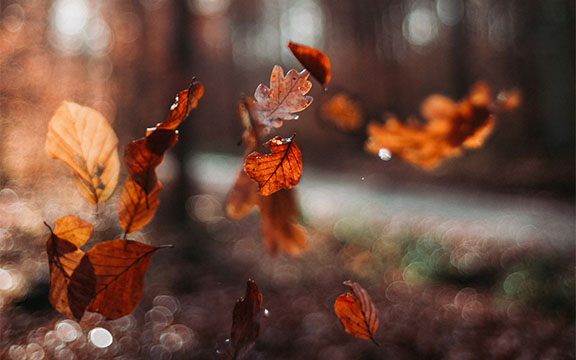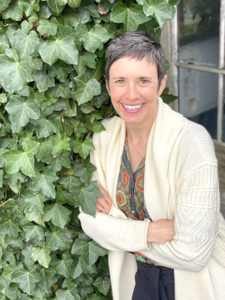
Photo by Oliver Hihn on Unsplash.
I crunched through the leaves toward the trailhead. A chill wind chased the clouds from the turquoise face of the sky. I paused under the maple tree to chant Om before my morning walk. In the branches overhead, yellow leaves fluttered like prayer flags. One released and slowly rode the wind before settling at my feet.
I used to have a love/hate relationship with autumn leaves. Love for the season and its cozy fireside nights, chunky sweaters, and sweet apple cider steaming in my mug. Hate—or more accurately discomfort—at the proof that my need to be in control was a self-devised trap of suffering. The piles of leaves on the driveway and on the lawn tempted me to exert control; I was not yet ready to sit humbly at the feet of that most overused yet essential phrase of spiritual life: to let go.
In my late twenties I was eager to prove my worth as a “woman who has it all together.” I lived in Chicago with my then-husband and when our enormous elm trees dropped their leaves I sprang into action. I blew them onto tarps and hauled them to the curb, delighting when the town came by to vacuum them into an enormous truck.
But I began to miss collection days when the pressure of “woman who has it all together” cracked under a full teaching load and a crumbling marriage. Now, I had to scoop the leaves into oversized paper collection bags. But there was always a pile in the corner of the fence or blowing into the neighbor’s yard. Each uncollected leaf felt like I was showing the world my weakness.
A few years later I had divorced and remarried. After moving to Massachusetts, new hubby and I moved into a small cottage in the woods. We were surrounded by enormous Eastern White pine trees and named our place “Pine Cottage”. I thought Aha! No more leaf collection! I’ve really made it now!
But soon I learned that in autumn, pine needles turn russet and drop. Needles that drift into piles. Needles that become slick with rain and cause you to slip on the garden path. Needles with pine sap that stick to your windshield wiper directly at eye level. Needles with sap that adhere to your pants only to be discovered at the end of a day, leaving you to wonder how many of your students and colleagues noted the needles on the seat of your pants.
I dutifully fell into my controlling pattern. I cleared them and obsessed each time the wind blew. I had married a fellow spiritual seeker who sagely stayed away when I was in manic leaf-cleaning mode. Once he said, “What’s the big deal? The wind will blow them away and anyway they are good for the garden.”

Joshua Woroniecki on Unsplash.
I glared at him, muttering something about it looking untidy. He could probably tell I was raging an internal battle and that it was best left between me and the gods of Autumn.
A few years later at Pine Cottage, I was fed up and paid a company to come and “take care” of the needles. Like a landscape mafia they descended. Soon leaf blowers roared and gas fumes filled the air. After they left, the dried ornamental grasses and mauve hydrangea mop heads were gone. What had thrummed with life was now barren and flat; not even a lone bird foraged for insects. Our cozy cottage garden had been sandblasted. I felt ashamed.
I began to think my efforts to control were misplaced. I was at war with two opposing ideas: doing versus allowing. Maybe instead I could begin to release my ego; take all of its complicated stories and judgments and work with life instead of fighting it. It was time to surrender to Autumn.
A few years later, hubby and I moved to a patch of land we call “Three Dog Farm.” Here, the leaves on the lawn get mowed and left in place as fertilizer. The leaves on the driveway and paths get blown into the wood or added to the compost heap. The perennial beds are left leaf-covered to create a natural top dressing that insulates the earth and protects insects. Our gardens are alive with bugs and birds, movement and color, and are just the right amount of messy.
When a tree releases her leaves, she surrenders in this elusive “letting go” that used to scare me. Autumn leaves are humble, fluttering down to prostrate their individual selves in service of the whole. This bowing down, a humble pranam, is not a negation of self or giving up of self-advocacy; rather it is an empowering act of aligning oneself in harmony with the entire universe.
There is a phrase in The Bhagavad Gita: “If you seek enlightenment from those who have realized the truth, prostrate before them, question them and serve them. Only then are you open to receive their teachings of sacred knowledge” (The Living Gita, 4:34). This act of prostration is what I avoided—and still do sometimes—when I try to control life.
This autumn I’ve been somewhat laid-back about the leaves. And when my mind’s tendency to over-control comes roaring forward, I head out into the garden. I place my hands on the earth and prostrate before the humble wisdom of the trees. I let my ego bleed into the soil. I learn, once again, the power of letting go.
About the Author:
 Gita Brown is a wellness activist, musician, and writer. She is a certified Advanced Integral Yoga® teacher and licensed Yoga for the Special Child® practitioner. Through her “Yoga with Gita courses” and podcast, “The Gita Brown Show,” her mission is to teach her students how to adapt the traditional practices of Yoga to bring more ease, wellness, and joy into everyday life. Gita started Yoga as a teenager, when her love of Yoga grew in tandem with her career as a classical clarinetist and music therapist. For three decades, she has taught Yoga, wellness, and music courses at colleges, schools of music, community schools, private studios, public schools, and hospitals. She is currently finishing final revisions to her memoir. The story is about how she repurposed her wedding vows into a yogic vow to live love as a way of life—a pilgrimage that endured even as her husband and childhood sweetheart battled end-stage alcoholism. She offers Yoga to students of all ages and abilities through online programs and in person at her home studio at Three Dog Farm in Kingston, Massachusetts. Learn more about her services by visiting: https://www.gitabrown.com
Gita Brown is a wellness activist, musician, and writer. She is a certified Advanced Integral Yoga® teacher and licensed Yoga for the Special Child® practitioner. Through her “Yoga with Gita courses” and podcast, “The Gita Brown Show,” her mission is to teach her students how to adapt the traditional practices of Yoga to bring more ease, wellness, and joy into everyday life. Gita started Yoga as a teenager, when her love of Yoga grew in tandem with her career as a classical clarinetist and music therapist. For three decades, she has taught Yoga, wellness, and music courses at colleges, schools of music, community schools, private studios, public schools, and hospitals. She is currently finishing final revisions to her memoir. The story is about how she repurposed her wedding vows into a yogic vow to live love as a way of life—a pilgrimage that endured even as her husband and childhood sweetheart battled end-stage alcoholism. She offers Yoga to students of all ages and abilities through online programs and in person at her home studio at Three Dog Farm in Kingston, Massachusetts. Learn more about her services by visiting: https://www.gitabrown.com

